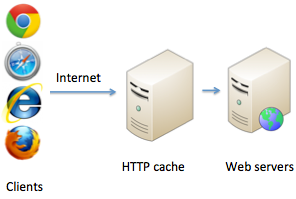Page 62
Server Cache
Posted on June 10th, 2010 by Victoria Pal in Monitoring Web caching describes the process of storing frequently used objects closer to the user through browser, proxy or server cache. Caching frequently used content has a positive effect in most cases because it reduces server load, bandwidth and latency. It also helps increase the responsiveness for users on the web.
Web caching describes the process of storing frequently used objects closer to the user through browser, proxy or server cache. Caching frequently used content has a positive effect in most cases because it reduces server load, bandwidth and latency. It also helps increase the responsiveness for users on the web.
Modern browsers support caching and require most elements of a page only during the first time a user opens that page. Then CSS files, images and other media are stored in a dedicated folder. This leads to faster loading times and better user experience. The whole process happens without any input from the user.
Server Virtualization Is Growing
Posted on June 2nd, 2010 by Victoria Pal in Tech "I think there is a world market for maybe five computers" is a famous misquote of Thomas J. Watson. The same Tom Watson, who took Computing Tabulating Recording Corporation and turned into what is today known as IBM. In essence, whoever said that the world will only need 5 computers wasn't totally wrong. Virtualization was first implemented in 1960 to aid better utilization of large mainframe hardware. 50 years later, it has grown to be part of all Fortune 100 success stories.
"I think there is a world market for maybe five computers" is a famous misquote of Thomas J. Watson. The same Tom Watson, who took Computing Tabulating Recording Corporation and turned into what is today known as IBM. In essence, whoever said that the world will only need 5 computers wasn't totally wrong. Virtualization was first implemented in 1960 to aid better utilization of large mainframe hardware. 50 years later, it has grown to be part of all Fortune 100 success stories.
Lately, "fake servers" became a slightly satiric way to say "virtual servers". Why? Mainly because they are gaining a larger market share. Large enterprises were quick to adopt the virtual machines approach, while small business started late. However, by year-end 2010, enterprises with 100 to 999 employees will have a higher penetration of virtual machines deployed than the Global 500. For long years, small businesses could not afford even the entry level products, and this is what changed lately. Increased competition by server vendors has made server virtualization technology affordable to smaller companies.
Remote Monitoring - Server, Desktop, Video and Mind
Posted on May 27th, 2010 by Victoria Pal in Monitoring I was on the computer, doing a search on "Remote Monitoring" the other day, and I came across one obvious, two common and one bizarre result.
I was on the computer, doing a search on "Remote Monitoring" the other day, and I came across one obvious, two common and one bizarre result.
Remote Server Monitoring
Remote monitoring is a phrase that needs context. It shouldn't even be the text itself, but it might be the main theme of a site, book, conversation, etc. For example, when you are reading this blog, you are thinking of website monitoring and remote server monitoring, which is quite normal. In fact, it means we've done our job right and you are here to learn more about monitoring of various network devices. Basically, what www.websitepulse.com is all about.
The 100% Server Uptime Illusion
Posted on May 25th, 2010 by Victoria Pal in Monitoring, Tech You've seen 98.9%, 99.9%, and even 100% server uptime labels on hosting sites. The first thought which comes up to people is, "Well, 99.9% sounds pretty well; 0.01% is no big deal," and they are right. Many people are missing because even if the server is reachable, it doesn't necessarily mean it's fully functional. So many other things can go wrong with a server. A 99.9% uptime sticker is no guarantee that your business won't face different problems while the server is up and running. Hosting providers calculate uptime in ways that aren't intuitive from a user's perspective, not considering certain website downtime.
You've seen 98.9%, 99.9%, and even 100% server uptime labels on hosting sites. The first thought which comes up to people is, "Well, 99.9% sounds pretty well; 0.01% is no big deal," and they are right. Many people are missing because even if the server is reachable, it doesn't necessarily mean it's fully functional. So many other things can go wrong with a server. A 99.9% uptime sticker is no guarantee that your business won't face different problems while the server is up and running. Hosting providers calculate uptime in ways that aren't intuitive from a user's perspective, not considering certain website downtime.
- First of all, not all downtime is counted. Scheduled maintenance is not part of the equation. Several hours of downtime is not what hosting companies would include. When monthly server uptime is calculated, such planned service interruptions are not included (deducted).
- Some, if not most, hosting providers tend to overlook shorter downtime periods. 3-5 minutes of unavailability are not considered significant and don't end up on the 99.9% sticker. You can see how multiple short downtime periods can make a difference at the end of the day.
- 0.01% means twice the trouble. 99.9% uptime means 8 hours and 45 minutes of downtime per year. So when you go down a notch to 98.9%, your calculated downtime goes up twice to 17 hours and 30 minutes.
- Resources are limited. "Unlimited" is just a nice way to sugarcoat "enough for the majority of common users." Your business might not be a common one, and demand might be high. There might be other significant sites sharing the same hosting hardware. At one point, it can all build up to an overload, resulting in poor loading times, broken transactions, and even a website. The server will remain online, but the performance won't meet your needs. Application monitoring is a good way to quickly and easily discover such problems.
100% uptime is not feasible. Eventually, something will go wrong. Network backbones will cause problems; power failures will happen, server software and hardware will fail now and then, and human error will always be important. So, my advice is: Don't try to find the ultimate provider, as it doesn't exist. Instead, find a decent provider with good server uptime and performance, 24-hour technical support, and frequent backups. Oh, why don't you go for a nice remote website monitoring service, just in case? It might be the best money you have ever spent.
Status Code 404 - Not Found
Posted on May 19th, 2010 by Victoria Pal in Monitoring It is quite common to see "404 Not Found" page instead of the requested one. This is a standard status code, informing the client that the server has not found anything matching this precise URI (short for Uniform Resource Locator). In other words, that is what you get when the server is not able to find the page you are trying to load, due to one reason or another.
It is quite common to see "404 Not Found" page instead of the requested one. This is a standard status code, informing the client that the server has not found anything matching this precise URI (short for Uniform Resource Locator). In other words, that is what you get when the server is not able to find the page you are trying to load, due to one reason or another.
This status code is commonly used. However, it is not the only error code you might get. 404, along with other 4xx status codes, is a client-side error, meaning that the user either misspelled or requested a page that is no longer there. On a different note, status 200 is the most common server reply you get. You don't see it because the request succeeded to display the requested resource.

 Copyright 2000-2025, WebSitePulse. All rights reserved.
Copyright 2000-2025, WebSitePulse. All rights reserved.